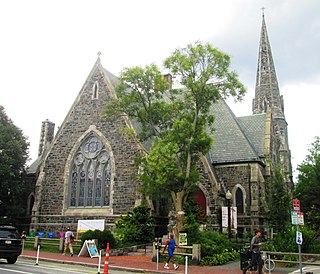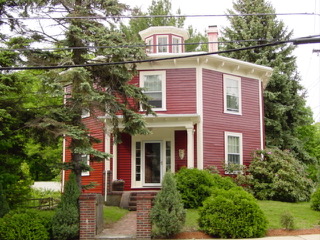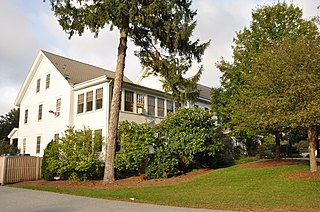The Cambridge Matignon School (originally Father Matignon High School) was a private, co-educational Roman Catholic college-preparatory school in Cambridge and Somerville, Massachusetts, United States. The school was under the auspices of the Roman Catholic Archdiocese of Boston.

Gridley James Fox Bryant, often referred to as G. J. F. Bryant, was a Boston architect, builder, and industrial engineer whose designs "dominated the profession of architecture in [Boston] and New England." One of the most influential architects in New England, he designed custom-made houses, government buildings, churches, schoolhouses, and private residences across the United States, and was popular among the Boston elite. His most notable designs are foundational buildings on numerous campuses across the northeastern United States, including Tufts College, Bates College, and Harvard College. One of the pioneers of modern architecture in America, he received the most commissions in New England during the height of his career. He is also the most commissioned architect in Boston history.

The National Register of Historic Places is a United States federal official list of places and sites considered worthy of preservation. In the state of Massachusetts, there are over 4,300 listings, representing about 5% of all NRHP listings nationwide and the second-most of any U.S. state, behind only New York. Listings appear in all 14 Massachusetts counties.

Christ Church, at Zero Garden Street in Cambridge, Massachusetts, U.S., is a parish of the Episcopal Diocese of Massachusetts. Built in 1760–61, it was designated a National Historic Landmark as one of the few buildings unambiguously attributable to Peter Harrison, the first formally trained architect to work in the British colonies.

International School of Boston is a bilingual co-educational TPS-12 private school in Cambridge, Massachusetts.

St. Joseph Catholic Church was a parish in the Roman Catholic Archdiocese of Boston, serving the Roxbury neighborhood of Boston, Massachusetts, USA. The parish was established in 1845, and a church was built in the same year. The entire church complex, including the rectory, convent and parish school, was added to the National Register of Historic Places in 1989. The parish was closed by the archdiocese in 2002, after which the property was sold.

The Charles Street Jail, also known as the Suffolk County Jail, is an infamous former jail located at 215 Charles Street, Boston, Massachusetts. It is listed in the state and national Registers of Historic Places. The Liberty Hotel, as it is now known, has retained much of its historic structure, including the famed rotunda.

Powder House Square is a neighborhood and landmark rotary in Somerville, Massachusetts, United States. It is also known locally as Powder House Circle. It is the six-way intersection of College Avenue, Broadway, Warner Street, and Powder House Boulevard. Powder House Square stands at the southern tip of Tufts University's main Somerville/Medford campus, and borders the northern edge of Nathan Tufts Park. The square takes its name from the 18th century Powder House, which overlooks the rotary from Nathan Tufts Park.

The Old Cambridge Baptist Church is a historic American Baptist church at 400 Harvard Street in Cambridge, Massachusetts.

St. John the Evangelist is a historic Roman Catholic Church at 2270 Massachusetts Avenue in Cambridge, Massachusetts.

The William Bryant Octagon House is an historic octagon house located at 2 Spring Street in Stoneham, Massachusetts. Built in 1850, it is the best-preserved of three such houses built in the town in the 1850s. It was listed on the National Register of Historic Places in 1984.

The former First Unitarian Church is a historic church building at 130 Highland Avenue in Somerville, Massachusetts. The stone church was built in 1894 for a Unitarian congregation. It was designed by Hartwell & Richardson and is a good example of Richardsonian Romanesque design. The building presently (2022) houses the Mission Church of Our Lord Jesus Christ.

The West Somerville Branch Library is a historic library at 40 College Avenue in Somerville, Massachusetts, just outside Davis Square. It is an example of Classical Revival architecture, built in 1909 with funding support from Andrew Carnegie, and was the city's first branch library. It was listed on the National Register of Historic Places in 1989.

The Adams-Magoun House is a historic house at 438 Broadway in Somerville, Massachusetts. Built about 1783, it is one of the city's few surviving 18th-century buildings and its best-preserved. It was listed on the National Register of Historic Places in 1989.

The Almshouse is a historic almshouse in Stoneham, Massachusetts. Built in 1852, it is one of the few surviving buildings of this type in the Greater Boston area. It is now part of the Stoneham Senior Center, and was listed on the National Register of Historic Places in 1984.
The Leverett Street Jail (1822–1851) in Boston, Massachusetts served as the city and county prison for some three decades in the mid-19th century. Inmates included John White Webster. Notorious for its overcrowding, the facility closed in 1851, when inmates were installed in the nearby, newly built Charles Street Jail, also in the West End.

Shepard S. Woodcock (1824–1910) was an American architect practicing in Boston, Massachusetts during the second half of the nineteenth century.

The Somerville City Hall is a historic municipal building at 93 Highland Avenue in Somerville, Massachusetts. Built in 1852 and enlarged several times, it has served as the city's first high school, first public library, and only city hall. The building was added to the National Register of Historic Places in 1989.

The Sacred Heart Parish Complex is a historic former Roman Catholic church complex located at 321 S. Broadway in Lawrence, Massachusetts. It consists of five buildings built between 1899 and 1936, including a fine Gothic Revival stone church. A historic district encompassing the complex was listed on the National Register of Historic Places on November 29, 2011. The complex was sold by the Roman Catholic Archdiocese of Boston in 2004 in order to help pay for the liabilities related to the sex abuse scandal, payouts for the scandal so far is approximately $4,000,000,000 church wide.

The Cheshire County Courthouse, located at 12 Court Street in Keene, New Hampshire, is the center of government of Cheshire County, New Hampshire. Completed in 1859 to a design by Gridley James Fox Bryant, it is believed to be the oldest courthouse in regular use in the state. It was added to the National Register of Historic Places on December 13, 1978.





















